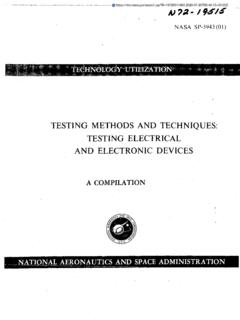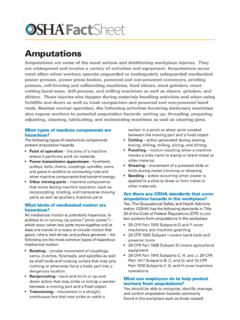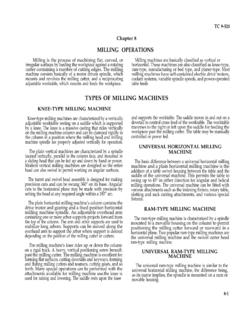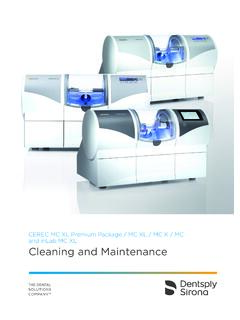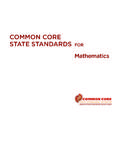Transcription of Introduction to Friction Stir Welding (FSW) - NASA
1 Introduction to Friction stir Welding (FSW) Bob Carter NASA Glenn Research Center Advanced Metallics Branch Agenda Short History of Aluminum Welding at NASA FSW Background and Applications Conventional FSW Self Reacting FSW Advantages and Disadvantages Microstructure and Avoidable Defects Specifications and Non Destructive Evaluation Process Variants Equipment and Tooling A lifetime in rocketry has convinced me that Welding is one of the most critical aspects of the whole job!! Dr. Wernher von Braun. 2 Short History of Aluminum Welding at NASA Late 1950 s Early 1970 s (Explorer 1, Mercury, Gemini, Saturn) Welding of aluminum alloys in its infancy Jupiter, Redstone, Saturn I, and Saturn V welded using Gas Metal Arc Welding (GMAW) and Gas Tungsten Arc Welding (GTAW) Horizontal Welding of tank structures led to significant Welding problems.
2 Porosity and hot cracking key concerns. Early 1970 s Mid 1980 s (Shuttle External Tank) GTAW continued to be State of Art Welding position changed to vertical to reduce porosity Defect rate was a continual problem due to the long duration between weld prep and Welding Mid 1980 s 1990 s Plasma Arc Welding (PAW) and Variable Polarity Plasma Arc Welding (VPPAW) developed to replace GTAW Greatly reduced the number defects Above: Closeout Welding operation of the liquid oxygen tank for the Saturn V SA-501 vehicle for the Apollo 4 mission. 1965 Space Shuttle External Tank major weld area. 1977 3 Short History of Aluminum Welding at NASA 2000 s - Present Aluminum-Lithium alloy 2195 implemented on External Tank 2195 has a propensity for hot cracking, particularly in repair welds This drove NASA s participation in the initial group sponsored projects on Friction stir Welding that were led by The Welding Institute First production Friction stir welds on External Tank were made in 2001 Friction stir Welding implemented for assembly of the Space Launch System, and on all elements of NASA s exploration program Welding of the SLS spacecraft adaptor at MSFC.
3 Nov 2012 [1] Welding of the Orion capsule at MAF. [2] Welding of Space Shuttle External Tank Barrel Sections. 4 Looking Forward NASA s building the Space Launch System (SLS) using FSW Will be the most powerful rocket in history 384 ft tall 130 Metric Ton (286,000 lb) payload capacity Million lbs of thrust (Saturn V had Million lbs) At the Michoud Assembly Facility (MAF) the largest FSW system ever is currently being installed to assemble the cryogenic tanks. 5 Reference [3] Reference [3] Reference [3] FSW Background Friction stir Welding is a solid-state process that was patented in 1991 by The Welding Institute (TWI) of Cambridge, England [5]. This patent is now expired.
4 Since its invention the process has generated significant interests in the R&D community. By 2007, 1800 patents had been issued relating to Friction stir Welding [6]. This number is now ~ The past decade has seen FSW applied in the aerospace, military, naval, rail, auto, and most recently computer industries. The new iMac [4] Welding Laboratory at NASA Marshall Space Flight Center 6 Some (many others not listed) Production Applications Marine: Prefabricated deck panels Aluminum plate to extrusions Armor plate for various assault vehicles Rocket Fuel Tanks Primarily square butt welds in 2 XXX series Aluminum. Space Shuttle External Tank United Launch Alliance Delta II, Delta IV, and Atlas V Space X Falcon and Falcon 9 Japan JAXA H-IIB NASA Space Launch System Core Stage Aircraft Primary Structure Eclipse 550 wing and fuselage Skin to Stringer Embrarer Legacy 450 and 500 Automotive Ford GT center tunnel Lincoln Towncar engine cradle and suspension struts Mazda RX5 Spot weld aluminum to galvanized steel Mazda RX8 and Toyota Prius trunk lids Wheels Volvo V70 seats Pipeline Field Welding of steel pipe Prefabricated Deck Panels [7] Eclipse 500 [7] 7 Operational Description.
5 Tool is plunged into workpiece until the tool shoulder is in contact with the part traverses the weld joint is withdrawn Basic parameters: RPM Travel speed Plunge load or plunge position Tool lead angle Tool design/geometry The Conventional Friction stir Welding Process Backing Anvil Plunge Force Rotation Pin Tool Travel Workpiece Key Points: Solid state (no melting) Non-consumable Tool No filler metal Shielding gas not required for Aluminum alloys Solid backing anvil Thickness and Travel Speed 8 How does it work? 9 Heat is generated by Friction between the tool and workpiece material Material adjacent to the tool softens The softened material is mechanically mixed by the tool The softened material is joined using mechanical pressure supplied by the tool shoulder FSW Tool Design Standard Tool Geometry: Concave shoulder and threaded pin.
6 Pin tread drives material toward the root during Welding . (clockwise rotation with left hand thread) Role of the Shoulder Provides biggest component of heat generation Plunged below the surface of the material to generate a high pressure forging action Confines the plasticized material Role of the Pin Establish stirring action Common variants to standard tool geometry : Tapered Pins Fluted Pins Scrolled Shoulders Used to reduce loads, improve material flow, and increase travel speed Pin Shoulder Standard Tool Geometry Variant of standard geometry with tapered fluted pin and scrolled shoulder 10 Scrolled Shoulder [8] Scrolled Shoulder The development of the scroll-type shoulder geometry eliminated the need for a lead angle Prior to this all Welding was performed using a negative lead angle Retractable Pin Tool NASA Patented [9] A device capable of manipulating the length of the Welding pin in real time Allows Welding tapered-thickness joints Can be used to eliminate the hole left at the end of the weld.
7 Aids in the avoiding lack of penetration defects Evolutionary Enhancements to FSW Travel Plunge Force Anvil Rotation Lead Angle Adjustable Pin Length Retractable Pin Tool Scrolled Shoulder Conventional FSW with a lead angle 11 Travel Pinch Force Rotation Self Reacting Friction stir Welding (SR-FSW) Pin Axis The scrolled shoulder and retractable pin tool technologies enabled development of SR-FSW Process Description: No anvil required Rotating tool pinches the work piece between two shoulders and traverses along the weld joint. Advantages Simplifies Tooling Eliminates Lack of Penetration Defects Disadvantages Hole left at end of weld 12 Movie Time 13 FSW Advantages Weld Property Advantages No melting No solidification defects (porosity, solidification cracking, liquation cracking).
8 Improved joint efficiency (strength) Lower processing temperature results in less damage in the weld heat affected zone. In precipitation strengthened aluminum alloys we typically see ~20% increase in as-welded ultimate tensile strength relative to fusion Welding . Improved fracture properties Dynamically recrystallized stir zone with extremely fine grain structure. Low distortion Processing Advantages Limited ability to join dissimilar metals Full penetration in a single pass Low occurrence of defects Fully automated and extremely repeatable No consumables Shielding gas may be required when Welding reactive metals. No position/orientation limitations Post-weld processing is not typically required Safety and Health No arc, fumes, or molten spatter 14 FSW Disadvantages Disadvantages High initial investment in tooling and equipment Sensitive to Joint Tolerances Not forgiving of pre-weld mismatch and gap Mismatch can lead to excessive flash Fixed Penetration - Lack of Penetration Defect Concern Lack of full penetration can result in kissing bonds that are difficult to detect using non-destructive testing.
9 Avoidance requires precise control of pin position relative to backing anvil. Exit hole left at the end of the weld Tool material limitations Example kissing bond Example Excessive Flash 15 Rotation Travel DYNAMICALLY RECRYSTALLIZED ZONE (DXZ) PARENT METAL THERMOMECHANICAL ZONE (TMZ) HEAT AFFECTED ZONE (HAZ) Microstructural Features and Nomenclature 16 Wormhole located on the advancing side Crown view Weld cross section Wormhole Galling Hook Defect in Lap Welds Uncommon FSW Defects All are easily mitigated in Aluminum alloys and are not encountered in production 17 Reference [11] Specifications and Verification Methods ISO 25239 and AWS are standards for FSW of Aluminum As built weld properties verified through.
10 Non destructive inspection Dye penetrant crown side surface inspection not practical due to tool marks. Root side of conventional welds with etch to look or lack of penetration. Radiographic volumetric inspection for gross flaws. Phased Array Ultrasonic Testing (PAUT) used by most in industry Process control Qualified weld operators Qualified weld procedures Calibrated equipment Post weld geometric inspections 18 Common Process Variants Mazda Friction Spot Welding [13] Friction Spot Welding [12] Friction Spot Welding Lap Welding Lap joints are common in Friction stir Welding Watch out for hook defect an uplift of surface oxides into the joint. Friction stir Processing Using Friction stir Welding technique to modify properties.
